<Back to Index>
- Co-founder of the Liberal Catholic Church Charles Webster Leadbeater, 1854
- Co-founder of the Liberal Catholic Church James Ingall Wedgwood, 1883
PAGE SPONSOR
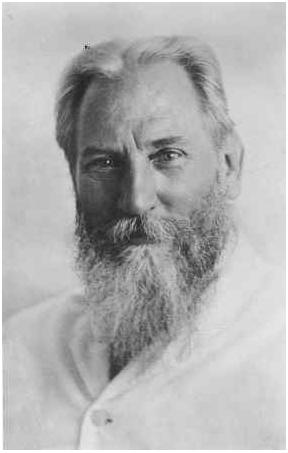
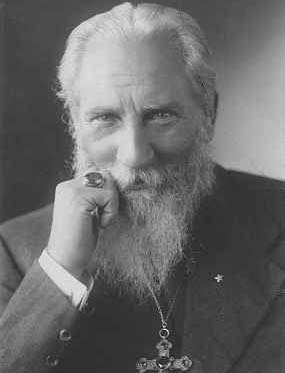
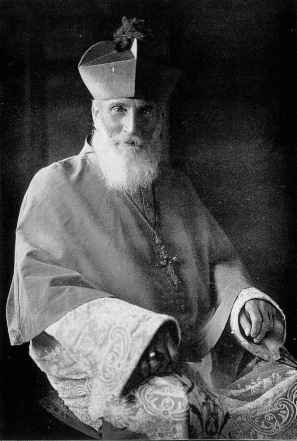
Charles Webster Leadbeater (16 February 1854 – 1 March 1934) was an influential member of the Theosophical Society, author on occult subjects and co-initiator with J.I. Wedgwood of the Liberal Catholic Church. Originally a priest of the Church of England, his interest in spiritualism caused him to end his affiliation with Anglicanism in favor of the Theosophical Society, where he became an associate of Annie Besant. He became a high ranking officer of the society, but resigned in 1906 after accusations that he had engaged in sex (mutual masturbation) with teenage boys in his care. With Besant's assistance he was readmitted a few years later. Similar rumors occurred throughout his career, but Leadbeater's talents as a prolific author on occultism kept him an important presence in Theosophy until his death in 1934.
Leadbeater was born in Stockport, Cheshire, in 1854. His father, Charles Sr., was born in Lincoln and his mother Emma was born in Liverpool. He was an only child. By 1861 the family had relocated to London, where his father was a railway contractor's clerk. Charles Sr. died from tuberculosis in 1862, when Leadbeater was only eight years old. Four years later a bank in which the family's savings were invested became bankrupt. Without finances for college, Leadbeater sought work soon after graduating from high school in order to provide for his mother and himself. He worked at various clerical jobs. During the evenings he became largely self educated. For example, he studied astronomy and had a 12 inch reflector telescope (which was very expensive at the time) to observe the heavens at night. He also studied French, Latin and Greek.
An uncle, his father's brother - in - law, was the well known Anglican clergyman, William Wolfe Capes. By his uncle's influence, Leadbeater was ordained an Anglican priest in 1879 at Farnham by the Bishop of Winchester. By 1881, he was living with his widowed mother at Bramshott in a cottage which his uncle had built, where he is listed as "Curate of Bramshott". He was an active minister and teacher who was remembered later as "a bright and cheerful and kindhearted man." About this time, after reading about the séances of medium Daniel Dunglas Home (1833 – 1886), Leadbeater developed an active interest in spiritualism.
His interest in occultism was stimulated by A.P. Sinnett's Occult World, and he joined the Theosophical Society in 1883. The next year he met Helena Petrovna Blavatsky when she came to London; she accepted him as a pupil and he became a vegetarian.
Around this time he received a number of so-called Mahatma Letters which he stated influenced him to go to India; he arrived at Adyar in 1884. He wrote that while in India, he had received visits and training from some of the "Masters" that according to Blavatsky were the inspiration behind the formation of the Theosophical Society, and were its hidden guides. This was the start of a long career with the Theosophical Society.
During 1885, Leadbeater traveled with Henry Steel Olcott (1832 – 1907), first President of the Theosophical Society, to Burma, and Ceylon (now Sri Lanka). In Ceylon they founded the English Buddhist Academy, with Leadbeater staying there to serve as its first headmaster under very austere conditions. This school gradually expanded to become Ananda College, which now has more than 6,000 students and has a building named for Leadbeater.
In 1889, Sinnett asked Leadbeater to return to England to tutor his son and George Arundale (1878 – 1945). He agreed and brought with him one of his pupils Curuppumullage Jinarajadasa (1875 – 1953). Although struggling with poverty himself, Leadbeater managed to send both Arundale and Jinarajadasa to Cambridge University. Both would eventually serve as International Presidents of the Theosophical Society. Jinarajadasa related how Leadbeater had already done some occult investigations, then in May 1894, did his first past life reading.
He became one of the best known speakers of the Theosophical Society for a number of years and was also Secretary of the London Lodge.
He added seven years to his stated age. For a ship's manifest in 1903, he listed his age as 56, and his occupation as "lecturer" when he did a lecture tour to Vancouver and San Francisco. He also stated that he had come previously to Seattle in 1893.
Mary Lutyens stated that starting in 1895 Leadbeater and Annie Besant reputedly made "...occult investigations together into the cosmos, the beginnings of mankind, chemistry and the constitution of the elements, as well as frequently visiting the Masters together in their astral bodies".
In 1906 Leadbeater was accused of having encouraged adolescent boys, pupils under his spiritual and secular instruction, to masturbate. Mary Lutyens wrote in Krishnamurti: The Years of Awakening:
Then in 1906, after Leadbeater's return to England, the fourteen year old son of the Corresponding Secretary of the Esoteric Section in Chicago, whom Leadbeater had taken with him to San Francisco on his first lecture tour, confessed to his parents the reason for the antipathy he had conceived for his mentor, to whom he had at first been greatly devoted — Leadbeater had encouraged him in the habit of masturbation. Almost simultaneously the son of another Theosophical official in Chicago charged Leadbeater with the same offense without apparently there being any collusion between the two boys. Then a typewritten, unsigned, undated, cipher - letter was produced; it had been picked up by a suspicious cleaner on the floor of a flat in Toronto in which Leadbeater had stayed with the second boy and was said to have been written by Leadbeater. The code was simple and when broken revealed one passage of such obscenity, for those days, that the letter could not by law be printed in England. When decoded the offending passage read: "Glad sensation is so pleasant. Thousand kisses darling."
A commission was appointed by the American Section, but before the meeting Leadbeater resigned from the society to, as he told Olcott, "save the Society from embarrassment." On the nature of the accusation itself, Leadbeater wrote to Annie Besant:
So when boys came under my care, I mentioned this matter to them [masturbation], among other things, always trying to avoid all sorts of false shame, and to make the whole appear as natural and simple as possible.
Leadbeater argued that the build up of natural sexual pressure could lead boys to seek sexual relief either with prostitutes or with each other. He claimed that by discharging the pressure at regular intervals through masturbation, the boys could avoid the more serious karmic and moral consequences of illicit sexual encounters: "If he [one of the boys] finds any accumulation, he should relieve."
A similar accusation was made later by Hubert van Hook of Chicago, who at age 11 was selected by Leadbeater as a candidate for the "vehicle" of an expected "World Teacher". Of this accusation, Mary Lutyens states: "Hubert later swore to Mrs Besant that Leadbeater had 'misused' him, but as he was extremely vindictive by that time, his testimony, though unshaken, was perhaps not altogether reliable." On a separate occasion, Lutyens had this to say regarding Leadbeater and another of his favorite boys:
[Leadbeater] came prancing down the wharf like a great lion, hatless and in a long purple cloak, holding on to the arm of a very good looking blond boy of about fifteen. This was Theodore St John, an Australian boy of great charm and sweetness, who was Leadbeater's current favorite and who slept in his room.
Author John Kersey, in Arnold Harris Mathew and the Old Catholic Movement in England 1908 - 52, offers the following assessment:
Leadbeater was not interested in defending his position, but in a letter to Annie Besant wrote: "a natural function exists, which in itself is no more wrong than eating or drinking." Besant did not agree with this, taking an attitude more typical of her time... Leadbeater's approach was not that of the libertine, for he taught self control and moderation in sexual habits... but certainly he was frank in his talk of sex, as well as promoting a generally open attitude to the body that was forward looking in the early years of the century.
Leadbeater... believed that by teaching masturbation and encouraging it, he was making it less likely that sexual experimentation would lead to unwanted pregnancies, since contraception was not widely available at this time. A factor in this approach was also that initiates in the Theosophical Society, including Leadbeater himself, were expected to remain chaste and not engage in sexual relationships with others. In this context, Leadbeater's teachings on auto - eroticism were a means, as he saw it, to enable initiates to remain within these bounds.
In Victorian England such ideas and practices were considered shocking and unacceptable; they were universally condemned even by the most radical of medical writers. Medical warnings about the physical and emotional damage caused by "self abuse" were seconded by clergymen, and the consequent fears were exploited by quacks who touted patent devices and heroic cures for the affliction of masturbation. Scores of books and pamphlets encouraged young men to a higher standard of chastity. These pamphlets blended medical rhetoric with religious exhortation, and encouraged boys to store up these sexual energies for a more moral use.
None of the accusations resulted in trials in a court of law. A judge in a related custody case in India (Naranian vs. Besant, regarding the legal guardianship of Jiddu Krishnamurti and his brother Nityananda) remarked in his ruling that Leadbeater held "immoral ideas" – this prompted Annie Besant to support Leadbeater in a letter regarding the facts of the case and its coverage by The Times of London.
Olcott died in February 1907 in Perth, Australia. Annie Besant, after a political struggle, became president of the society. By the end of 1908, the International Sections voted for Leadbeater's readmission. He accepted and came to Adyar on 10 February 1909.
In 1909 Leadbeater "discovered" fourteen year old Jiddu Krishnamurti at Adyar. Leadbeater believed Krishnamurti to be the "vessel" for the indwelling of a concept known as World Teacher, whose imminent appearance he and many Theosophists were expecting. Like Moses, Siddhārtha Gautama, Zarathustra (Zoroaster), Jesus of Nazareth, and Muhammad ibn ‘Abdullāh, the new teacher would reputedly divulge a new religious dispensation.
Leadbeater assigned the pseudonym Alcyone to Krishnamurti and under the title "Rents in the Veil of Time", he published 30 so-called past lives of "Alcyone" in a series in The Theosophist magazine beginning April 1910. "They ranged from 22,662 BC to 624 AD ... Alcyone was a female in eleven of them."
During 1910, Leadbeater conducted additional research into the so-called akashic records, which he stated that he clairvoyantly inspected at the Theosophical Society headquarters in Adyar. He recorded the results in the book Man: How, Whence, and Whither? The reputed past lives of "Alcyone" are described. The book also features a Theosophical account of the theorized lost continent of Atlantis and of other civilizations. The future, nuclear power using society of Earth during the 28th century is also described.
Leadbeater stayed in India until 1915, overseeing the education of Krishnamurti; he then relocated to Australia. During the late 1920s, Krishnamurti disavowed the role that Leadbeater and other Theosophists expected him to fulfill. He disassociated himself from the Theosophical Society and its doctrines and practices, and during the next six decades became known as an influential speaker on philosophical and religious subjects.
Leadbeater moved to Sydney in 1915. He was responsible for the construction of the Star Amphitheatre at Balmoral Beach in 1924. While in Australia he became acquainted with J.I. Wedgwood, a Theosophist and bishop in the Liberal Catholic Church who initiated him into Co-Masonry in 1915 and later consecrated him as a bishop of the Liberal Catholic Church in 1916.
Public interest in Theosophy in Australia and New Zealand increased greatly as a result of Leadbeater's presence there, and Sydney became comparable to Adyar as a center of Theosophical activity.
In 1922, the Theosophical Society began renting a mansion known as The Manor in the Sydney suburb of Mosman. Leadbeater began residence there as the director of a community of Theosophists. The Manor became a major site and was regarded as "the greatest of occult forcing houses". There he accepted young women students. They included Clara Codd, future President of the Theosophical Society in America, clairvoyant Dora van Gelder, another future President of the Theosophical Society in America who during the 1970s also worked with Delores Krieger to develop the technique of Therapeutic touch, and Mary Lutyens, who would later write an authorized Krishnamurti biography. Lutyens stayed there in 1925, while Krishnamurti and his brother Nitya stayed at another house nearby. The Manor became one of three major Theosophical Society sites, the others being at Adyar and the Netherlands. The Theosophical Society bought The Manor in 1925 and during 1951 created The Manor Foundation Ltd, to own and administer the house, which is still used by the Society.
It was also during his stay in Australia that Leadbeater became the Presiding Bishop of the Liberal Catholic Church and co-wrote the Liturgy Book for that denomination, still in use today. This work represents a revision of the Roman Catholic liturgy of his time, for which Leadbeater sought to remove what he regarded as undesirable elements, such as the, in his view, blatant anthropomorphisms and expressions of the fear and wrath of God, which he regarded "as derogatory alike to the idea of a loving Father and to the men He has created in His own image. If Christians," he wrote, "had been content to take what Christ taught of the Father in heaven, they would never have saddled themselves with the jealous, angry, bloodthirsty Jehovah of Ezra, Nehemiah and the others - a god that needs propitiating and to whose 'mercy' constant appeals must be made."
Thus the Credo of the Liberal Catholic Church Liturgy written by Leadbeater reads:
- "We believe that God is Love and Power and Truth and Light; that perfect justice rules the world; that all His sons shall one day reach His Feet, however far they stray. We hold the Fatherhood of God, the Brotherhood of man; we know that we do serve Him best when best we serve our brother man. So shall His blessing rest upon us and peace for evermore. Amen."
Previously Leadbeater had investigated the energies of the Christian sacraments and written The Science of Sacraments: An Occult and Clairvoyant Study of the Christian Eucharist – one of the most significant works of Christian esotericism. In his prologue to the latest edition of this book, John Kersey refers to the Eucharist proposed by Leadbeater as "a radical reinterpretation of the context of the Eucharist seen within a theological standpoint of esoteric magic and universal salvation; it is Catholicism expressing the love of God to the full without the burdens of needless guilt and fear, and the false totem of the temporal powers of the church."
Leadbeater remains well known and influential in his work through his reputed clairvoyance with, for instance, his books The Chakras and Man, Visible and Invisible dealing with the human aura and chakras. In his book The Inner Life he wrote that there is a population of human like beings on the planet Mars (a popular belief at the time).
His writings on the sacraments and Christian esotericism remain popular, with a constant stream of new editions and translations of his opus magnum 'The Science of the Sacraments'. His Liturgy book is still used by many Liberal and Independent Catholic Churches across the world.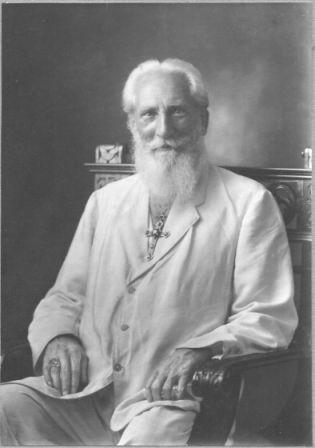
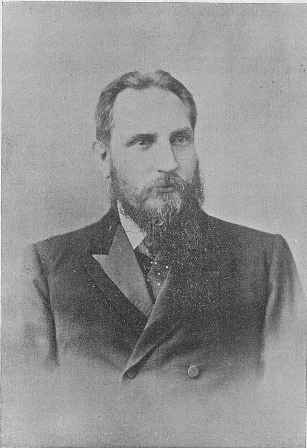
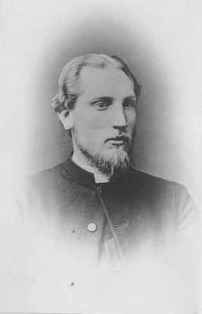
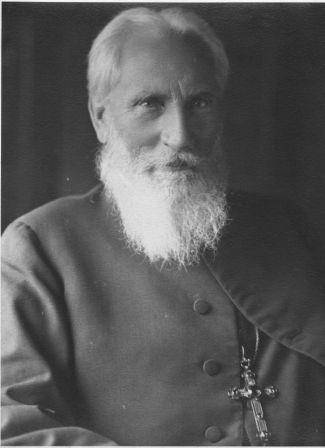
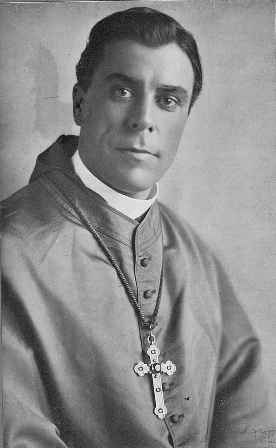
James Ingall Wedgwood (24 March 1883 – 13 March 1951) was the first Presiding Bishop of the Liberal Catholic Church.
Wedgwood was a former Anglican, a member of the Theosophical Society and a member of a co-Masonic order. His work on the Liberal Rite, as well as his efforts to establish a progressive branch of the One Holy Catholic and Apostolic Church, are his greatest legacies.
Wedgwood was born in London in 1883, the son of Alfred Allen Wedgwood, son of Hensleigh Wedgwood and Rosina Margaret Ingall. He studied at University College, Nottingham, with the intention of making a living as a chemist, but found himself attracted to High Anglican worship, becoming an altar server and later being sent to York Minster, where as choirmaster he trained boys in plainchant.
In 1904 Wedgwood attended a lecture on Theosophy given by Annie Besant in York. Having heard her once previously in Nottingham, he determined to end his interest in Theosophy by attending a second lecture and ridding himself of “that woman”. Three days later he joined the Theosophical Society and was forbidden to return to the church. Citing the local canon, he wrote: “The Vicar could not have such a heretic as a church official!” He gave up the idea of ever having a career in the church and decided to dedicate himself to the work of the Theosophical Society and serving as General Secretary of the Society in England and Wales from 1911 – 1913, resigning only to join the British Jurisdiction of the Co-Masonic Order.
In 1913, Wedgwood took notice of the Old Catholic Church in England and wrote a letter to Archbishop Arnold Harris Mathew. Mathew’s reply caught him somewhat by surprise and rekindled his interest in both the church and in entering holy orders again. They exchanged letters for a time and Wedgwood explained his affiliation to the Theosophical Society. Mathew did not express any concern over the matter at the time. The same year, Wedgwood was rebaptized and reconfirmed sub-conditione, received the Minor Orders including subdeacon. He was later ordained a deacon and finally a priest on 22 July 1913 in London. In 1915, Wedgwood visited Australia as Grand Secretary of the Order of Universal CoMasonry and met Charles Webster Leadbeater, a leading figure in the Theosophical movement. He initiated Leadbeater into Freemasonry and talked about his ordination to the priesthood in the Old Catholic Church. In his words: “I talked with him about my ordination and he came to various celebrations of the Eucharist by myself. He was greatly impressed by the power for good which such ordination bestowed and with the splendid scope that the celebration offered for spreading spiritual blessing abroad on the world.”
On his return to England, Wedgwood learned that one of the bishops of the church, Frederick Samuel Willoughby, had become enmeshed in a homosexuality scandal and as a result had been suspended by Archbishop Mathew. He also learned that Mathew wanted all the clergy of the church to renounce Theosophy as he had heard from a non - Theosophical priest that the beliefs of the society were incompatible. Few bothered to reply to Mathew and shortly thereafter Mathew "dissolved" his church. Bishop Willoughby offered to consecrate Wedgwood to the episcopate in order to guard the apostolic succession as he had received it. Wedgwood, however, aware that the charges against Willoughby were substantially true, approached a number of other bishops seeking consecration. He wrote to the Old Catholic Archbishop of Utrecht, by whom Mathew had originally been consecrated, but received no reply. He then approached Bishop Frederick James, a fellow Theosophist and homosexual and a number of other freelance bishops, but none would oblige. With no other options open, Wedgwood received from Willoughy, King and Gauntlett the apostolic succession on 13 February 1916. This took place only after Archbishop Mathew had dissolved the Old Catholic Church in Great Britain and published a letter in The Times announcing his intention to join the Roman Catholic Church.
Later that year Wedgwood again traveled to Australia where he consecrated Leadbeater a bishop in Sydney on 22 July 1916. Leadbeater eventually succeeded Wedgwood as Presiding Bishop of the LCC. From that time forward Wedgwood traveled the world as a missionary bishop, creating the Liberal Rite (a form of Christian liturgy) in co-operation with Leadbeater, establishing missions of the church and publishing a stream of works on theology and liturgy including New Insights into Christian Worship and The Presence of Christ in the Holy Communion.
Wedgwood was a homosexual with what he described as an "almost unbelievably strong" sexual urge (he once visited 18 public toilets in two hours, explaining to police that he had been "searching for a friend"). This was matched by a strong religious strain, and he was dominated by those two fundamental, but often conflicting, drives. In 1919, together with several other priests and bishops of the Liberal Catholic Church, he came under investigation for homosexual activities involving boys. The scandals continued through the following years, leading to Wedgwood's resignation from the Theosophical Society and various other bodies and organizations including the Liberal Catholic Church (12 March 1923), announcing in a letter to Annie Besant of the Theosophical Society that he would henceforth retire into private life.
Wedgwood now enrolled as a doctoral candidate at the Sorbonne, combining his studies with experiments at the works of a celebrated organ builder and activities at Russian Orthodox and Old Catholic churches. It was also in Paris that he became addicted to cocaine, which he used in quantity, smuggling it into England on his visits concealed in the head of his bishop's crozier. It was also in Paris that the symptoms of secondary syphilis manifested themselves - he had contracted the disease as the result of oral sex in Sydney but had refused to admit the fact or to take any treatment.
By 1924, with money running short, Wedgwood approached his old friend Annie Besant and through her influence again became involved with the church in Huizen, Netherlands, where he was offered a house and estate for his use. A little chapel was built and dedicated to St Michael and All Angels, where Wedgwood began to celebrate regular services. He also resumed his activities with the Theosophical Society, with increasingly frequent claimed visions and meetings with masters, angels, archangels and denizens of the higher realms.
Wedgwood died on 13 March 1951 in Farnham, Surrey, from a fall which broke several ribs and ruptured a lung. In the years before his death he continued to wander in and out of the dementia of tertiary syphilis, in the lucid periods devoting himself to the work of the center at Huizen and to the establishment of a lesser center at Tekels Park near Camberley, Surrey, in England, where he lived almost entirely from 1937 onwards. These periods became less and less over the years and during his last months he had to be kept from any involvement in public activities, even from eating in the communal dining room, because of his unpredictable behavior.
His death brought eulogies from his most devoted followers. Bishop Vreede wrote:
- "His crucifixion is at an end ... In utter defenselessness and harmlessness and in utter humility he took upon himself the vicarious atonement for the bearers of the apostolic succession he brought over to the Liberal Catholic Church and by that sacrifice occultly founded the church and opened a possibility for the redemption of the Lord's Church at large."
Privately, even his friends were more equivocal. E.L. Gardner, an eminent British Theosophist who was responsible for arranging for Wedgwood to be looked after in his declining years, wrote privately:
- "JIW was a 'dual' - at times skilled, able and impressive. Then a bout of sensualism of the worst grade, sexual perversion."